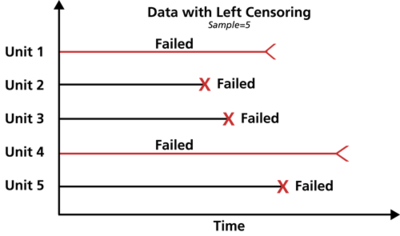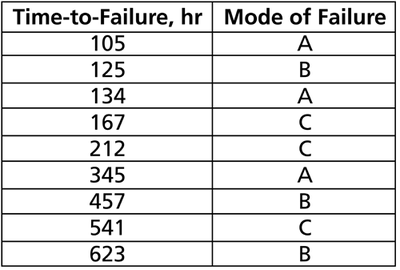Template:Alta data types: Difference between revisions
Chuck Smith (talk | contribs) |
Chuck Smith (talk | contribs) |
||
| Line 24: | Line 24: | ||
It is also possible that some of the units have not yet failed when the life data are analyzed. This type of data is commonly called right censored data, or suspended data. Assume that we tested five units and three failed. In this scenario, our data set is composed of the times-to-failure of the three units that failed (complete data) and the running time of the other two units that have not failed at the time the data is analyzed (suspended data). This is the most common censoring scheme and it is used extensively in the analysis of field data. | It is also possible that some of the units have not yet failed when the life data are analyzed. This type of data is commonly called right censored data, or suspended data. Assume that we tested five units and three failed. In this scenario, our data set is composed of the times-to-failure of the three units that failed (complete data) and the running time of the other two units that have not failed at the time the data is analyzed (suspended data). This is the most common censoring scheme and it is used extensively in the analysis of field data. | ||
<br> | <br> | ||
[[Image:rcendata.png|center| | [[Image:rcendata.png|center|200px ]] | ||
<br> | <br> | ||
<br> | <br> | ||
Revision as of 16:09, 26 April 2012
Data and Data Types
The analysis of accelerated life tests relies extensively on data. Specifically, analysis relies on life and stress data or times-to-failure data at a specific stress level. The accuracy of any prediction is directly proportional to the quality and accuracy of the supplied data. Good data along with the appropriate distribution and life-stress model usually result in good predictions. Bad or insufficient data will always result in bad predictions.
Most types of non-life data, as well as some life data, are what we term as "complete" data. Complete data means that the value of each sample unit is observed or known. In many cases, however, life data contains uncertainty as to when exactly an event happened (i.e. when the unit failed). Data sets containing such uncertainty as to exactly when the event happened are termed as "censored" data. Each type is explained next.
Complete Data
Complete data means that the value of each sample unit is observed (or known) [31]. For example, if we had to compute the average test score for a sample of ten students, complete data would consist of the known score for each student. For life data analysis, known times-to-failure comprise what is usually referred to as complete data. For example, if we tested five units and they all failed, we would then have complete information as to the time-to-failure for each unit in the sample.
Censored Data
There are three types of censored data: right censored, interval censored data and left censored Data. These different types are explained next.
Right Censored (Suspended) Data
It is also possible that some of the units have not yet failed when the life data are analyzed. This type of data is commonly called right censored data, or suspended data. Assume that we tested five units and three failed. In this scenario, our data set is composed of the times-to-failure of the three units that failed (complete data) and the running time of the other two units that have not failed at the time the data is analyzed (suspended data). This is the most common censoring scheme and it is used extensively in the analysis of field data.
Interval Censored Data
The second type of censoring is commonly called interval censored data. Interval censored data reflects uncertainty as to the exact times the units failed within an interval. This type of data frequently comes from tests or situations where the objects of interest are not constantly monitored. If we are running a test on five units and inspecting them every 100 hours, we only know that a unit failed or did not fail between inspections. More specifically, if we inspect a certain unit at 100 hours and find it is operating and then perform another inspection at 200 hours to find that the unit is no longer operating, we know that a failure occurred in the interval between 100 and 200 hours. In other words, the only information we have is that the unit failed in a certain interval of time. This is also called inspection data by some authors.
Since Interval data is less informative than complete data, it is recommended that they are avoided. This is especially the case in accelerated life tests where a life-stress relationship needs to be determined and interval data affect the accuracy of the fitted relationship, and subsequently the extrapolation to Use conditions. In some cases interval data is unavoidable, due to the nature of the product, the test, and the test equipment, but in these cases caution must be taken to set the inspection intervals to be short enough to observe the spread of the failures. For example, if the inspection interval is too long, all the units in the test may fail within that interval, and thus no failure distribution could be obtained. In accelerated life testing, inspection intervals should be chosen according to the expected acceleration factor at each stress level, and therefore these intervals will be of different length for each stress level.
Left Censored Data
The third type of censoring is similar to the interval censoring and is called left censored data. In left censored data, a failure time is only known to be before a certain time. For instance, we may know that a certain unit failed sometime before 100 hours but not exactly when. In other words, it could have failed any time between 0 and 100 hours. This is identical to interval censored data in which the starting time for the interval is zero.
Grouped Data Analysis
Data can also be entered into ALTA individually or in groups. Grouped data analysis is used for tests in which groups of units possess the same time-to-failure or in which groups of units were suspended at the same time. We highly recommend entering redundant data in groups. Grouped data speeds data entry by the user and significantly speeds up the calculations.
A Note about Complete and Suspended Data
Depending on the event that we want to measure, data type classification (i.e. complete or
suspended) can be open to interpretation. For example, under certain circumstances, and depending
on the question one wishes to answer, a specimen that has failed might be classified as suspended
for analysis purposes. To illustrate this, consider the following times-to-failure data for a
product that can fail due to modes A, B and C:
If the objective of analysis is to determine the probability of failure of the product regardless of the mode responsible for the failure, we would analyze the data with all data entries classified as failures (complete data). However, if the objective of the analysis is to determine the probability of failure of the product due to Mode A only, we would then choose to treat failures due to Modes B or C as suspended (right censored) data. Those data points would be treated as suspended data with respect to Mode A because the product operated until the recorded time without failure due to Mode A.

